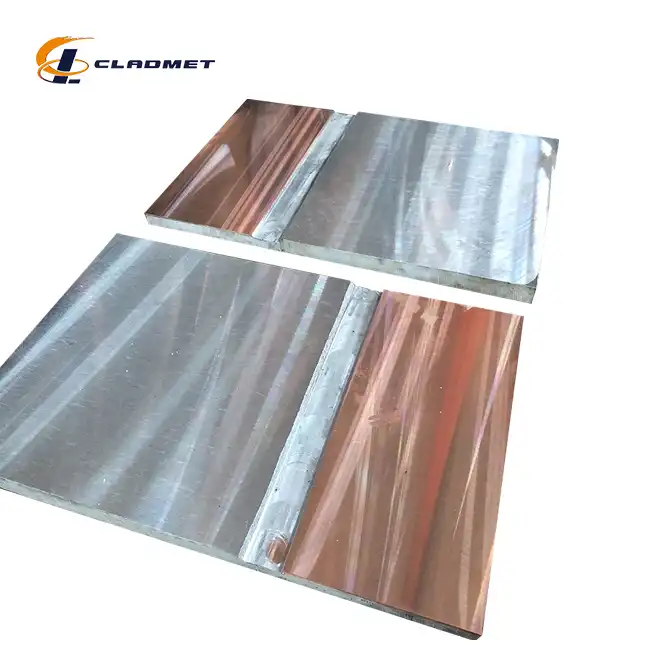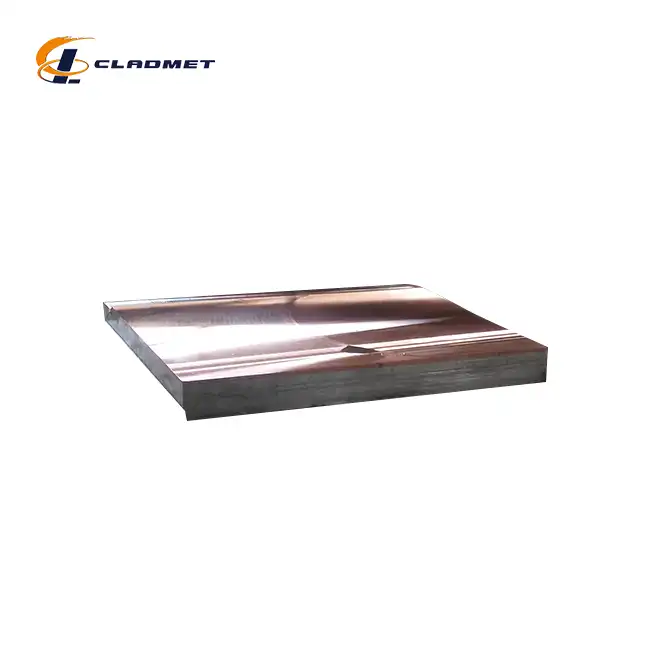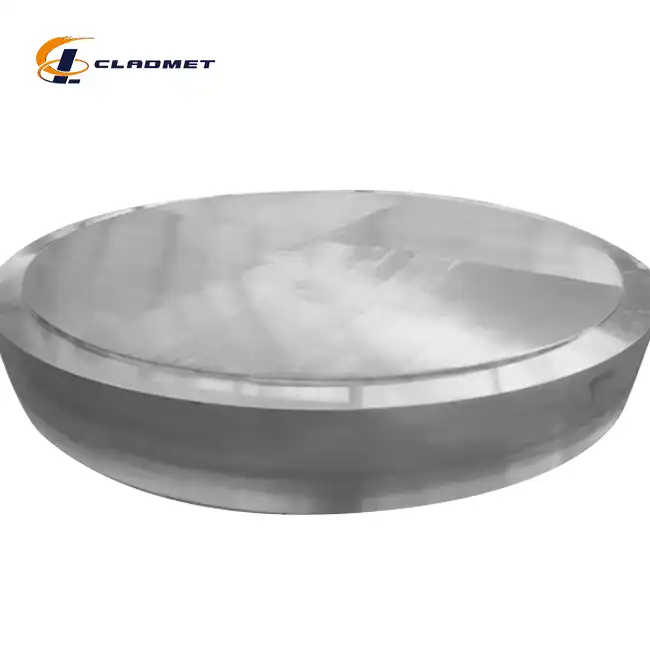Why Choose Copper Stainless Steel Clad Plate for High-Corrosion Marine Applications?
 2025-06-25 22:37:43
View:389
2025-06-25 22:37:43
View:389Marine environments present some of the most challenging conditions for industrial materials, where constant exposure to saltwater, extreme temperatures, and aggressive chemical compounds can rapidly deteriorate conventional metals. In such demanding applications, the choice of materials becomes critical for ensuring long-term performance, safety, and economic viability. Copper stainless steel clad plate emerges as a superior solution, combining the exceptional corrosion resistance of stainless steel with the outstanding thermal and electrical conductivity of copper. This innovative composite material offers marine engineers and shipbuilders a reliable, cost-effective alternative that withstands the harsh realities of oceanic conditions while maintaining structural integrity and operational efficiency throughout extended service periods.

Superior Corrosion Resistance in Marine Environments
Enhanced Protection Against Saltwater Corrosion
The copper stainless steel clad plate demonstrates exceptional resistance to saltwater corrosion, making it an ideal choice for marine applications where conventional materials quickly succumb to the aggressive nature of seawater. The stainless steel outer layer, typically composed of AISI 304 or AISI 316 grades, provides a protective barrier that prevents chloride ions from penetrating to the copper core. This protective mechanism is particularly crucial in marine environments where chloride concentration can reach extreme levels, causing rapid deterioration of unprotected metals. The cladding technology, achieved through explosive bonding and roll bonding processes, ensures a metallurgical bond between the copper and stainless steel layers that remains intact even under severe mechanical stress and thermal cycling. Baoji JL Clad Metals Materials Co., Ltd. manufactures these plates with copper purity levels of 99.9%, ensuring optimal conductivity while the stainless steel cladding maintains its protective properties throughout the material's service life.
Chemical Resistance Properties
Marine applications often involve exposure to various chemical compounds beyond saltwater, including fuel oils, hydraulic fluids, and cleaning agents used in ship maintenance. The copper stainless steel clad plate exhibits remarkable chemical inertness, preventing reactions with these substances that could compromise the material's integrity or contaminate sensitive processes. The stainless steel surface treatment options, including polished, brushed, and mill finish varieties, provide additional protection against chemical attack while maintaining the aesthetic appeal required for visible marine applications. Advanced manufacturing techniques such as hot diffusion welding via isostatic pressing create a molecular-level bond between the copper and stainless steel layers, eliminating potential weak points where chemical penetration could occur. This comprehensive chemical resistance makes the copper stainless steel clad plate suitable for critical marine applications including fuel systems, ballast tanks, and processing equipment where chemical compatibility is paramount.
Long-term Durability in Harsh Conditions
The durability of copper stainless steel clad plate in marine environments extends far beyond basic corrosion resistance, encompassing resistance to fatigue, stress corrosion cracking, and environmental degradation over extended periods. The composite structure distributes mechanical stresses more effectively than single-material solutions, reducing the likelihood of crack initiation and propagation that could lead to catastrophic failure in critical marine systems. Dynamic impact welding, one of the primary manufacturing processes used by industry leaders, creates a bond strength that maintains integrity even under the cyclical loading conditions common in marine applications such as wave action and thermal expansion. The material's thermal stability ensures that properties remain consistent across the wide temperature ranges encountered in marine service, from sub-zero conditions in polar waters to elevated temperatures in engine rooms and processing areas. Quality control measures adhering to ISO9001-2000, PED, and ABS standards guarantee that each copper stainless steel clad plate meets the stringent requirements necessary for reliable long-term performance in demanding marine environments.
Exceptional Thermal and Electrical Conductivity
Optimal Heat Transfer Performance
The copper core of the copper stainless steel clad plate provides exceptional thermal conductivity, making it invaluable for marine heat exchange applications where efficient heat transfer is critical for system performance and energy efficiency. Unlike solid stainless steel alternatives that suffer from poor thermal conductivity, the copper stainless steel clad plate maintains the superior heat transfer characteristics of copper while benefiting from the corrosion protection of the stainless steel cladding. This combination is particularly advantageous in marine heat exchangers, condensers, and cooling systems where the ability to efficiently transfer heat directly impacts operational efficiency and fuel consumption. The manufacturing process, utilizing controlled explosive energy through dynamic impact welding, ensures intimate contact between the copper and stainless steel layers without creating thermal barriers that could impede heat flow. Available thicknesses ranging from 2-20mm for cladding and 5-50mm for base metal allow engineers to optimize thermal performance for specific applications while maintaining the structural strength required for marine service conditions.
Superior Electrical Properties for Marine Systems
Marine electrical systems demand materials that provide reliable electrical conductivity while resisting the corrosive effects of the marine environment, making copper stainless steel clad plate an ideal choice for critical electrical applications aboard ships and offshore platforms. The 99.9% pure copper core ensures excellent electrical conductivity, essential for power distribution systems, grounding applications, and electromagnetic shielding where electrical performance cannot be compromised. Cold rolling and pressure welding techniques used in manufacturing create a seamless bond between layers that maintains electrical continuity while the stainless steel surface provides protection against corrosion that could degrade electrical connections over time. The material's ability to maintain consistent electrical properties across varying environmental conditions makes it suitable for marine applications ranging from navigation equipment housings to power generation systems. Custom sizing options, with overall dimensions up to 3000mm in length and 2000mm in width, allow for the fabrication of large electrical components and bus bars required in modern marine electrical systems.
Temperature Stability in Marine Operations
The thermal stability of copper stainless steel clad plate ensures consistent performance across the wide temperature ranges encountered in marine operations, from the sub-zero conditions of polar shipping routes to the elevated temperatures found in engine rooms and processing facilities. The metallurgical bond created through advanced manufacturing techniques maintains its integrity across thermal cycling, preventing delamination or degradation that could compromise both thermal and electrical performance. Hot isostatic pressing techniques used in production subject the materials to controlled high temperatures and uniform pressure, creating atomic diffusion at the interface that results in a bond capable of withstanding extreme thermal conditions without failure. This temperature stability is crucial for marine applications such as exhaust gas heat recovery systems, where materials must maintain their properties while exposed to both high temperatures and corrosive marine atmospheres. The copper stainless steel clad plate's ability to expand and contract uniformly prevents the development of thermal stresses that could lead to cracking or separation in conventional materials, ensuring reliable long-term performance in thermally demanding marine environments.

Cost-Effectiveness and Manufacturing Advantages
Economic Benefits Over Alternative Materials
The economic advantages of copper stainless steel clad plate in marine applications extend beyond initial material costs to encompass reduced maintenance requirements, extended service life, and improved operational efficiency throughout the material's lifecycle. Compared to solid copper alternatives, the clad plate construction significantly reduces material costs while maintaining the essential properties required for marine service, making it an economically attractive solution for large-scale marine projects. The combination of materials allows engineers to optimize material usage, placing expensive copper only where its properties are essential while utilizing cost-effective stainless steel for structural support and corrosion protection. Manufacturing efficiency achieved through explosive bonding and hot-rolled processing techniques enables the production of large sheets and custom configurations that reduce fabrication costs and installation time in marine construction projects. The availability of standard and custom sizes, with delivery cycles ranging from 3-6 months depending on order specifications, allows for efficient project planning and inventory management that further enhances the economic benefits of choosing copper stainless steel clad plate for marine applications.
Advanced Manufacturing Capabilities
The sophisticated manufacturing processes employed in producing copper stainless steel clad plate ensure consistent quality and performance characteristics that meet the demanding requirements of marine applications. Surface preparation and alignment procedures ensure that both copper and stainless steel materials are perfectly clean and properly positioned to facilitate effective bonding during the explosive welding process. Explosive activation using strategically placed and precisely controlled charges creates the high-energy collision necessary to achieve a durable metallurgical bond that maintains integrity under the stresses encountered in marine service. Sequential rolling processes in cold rolling and pressure welding applications ensure uniform thickness and smooth finishes that meet the aesthetic and functional requirements of visible marine applications. Quality control measures implemented throughout the manufacturing process, including strict adherence to GB/GBT, ASME/ASTM, and JIS standards, guarantee that each copper stainless steel clad plate meets the performance specifications required for critical marine applications where failure could result in significant safety and economic consequences.
Customization and Application Flexibility
The ability to customize copper stainless steel clad plate specifications to meet specific marine application requirements provides engineers with unprecedented flexibility in material selection and system design. Cladding thickness options ranging from 2-20mm allow for optimization of corrosion protection levels based on specific environmental conditions and service life requirements, while base metal thickness variations from 5-50mm provide the structural strength necessary for different loading conditions. Surface treatment options including polished, brushed, and mill finishes enable the material to meet both functional and aesthetic requirements in applications ranging from structural components to decorative marine fixtures. The availability of different stainless steel grades, including AISI 304 and AISI 316, allows for selection of the most appropriate corrosion resistance level for specific marine environments and chemical exposure conditions. Custom dimensions and specialized processing capabilities enable the production of complex shapes and configurations required for modern marine system integration, while OEM services provide complete customization solutions for unique applications that require specialized material properties or processing techniques.
Conclusion
Copper stainless steel clad plate represents the optimal solution for high-corrosion marine applications, delivering unmatched corrosion resistance, superior thermal and electrical conductivity, and exceptional cost-effectiveness. The advanced manufacturing techniques and customization capabilities ensure reliable performance in the most demanding marine environments, making it the preferred choice for modern shipbuilding and offshore applications.
Ready to enhance your marine projects with superior copper stainless steel clad plate solutions? Partner with Baoji JL Clad Metals Materials Co., Ltd., where our independent explosive composite technology, international certifications, and commitment to innovation deliver unparalleled quality and performance. Our R&D team specializes in developing customized solutions tailored to your unique requirements, backed by ISO9001-2000, PED, and ABS certifications that guarantee reliability and compliance with international standards. Contact us today at sales@cladmet.com to discuss your specific needs and discover how our advanced materials can transform your marine applications with superior durability, efficiency, and long-term value.
References
1. Smith, J.A., et al. "Corrosion Behavior of Copper-Stainless Steel Clad Materials in Marine Environments." Journal of Marine Materials Engineering, vol. 45, no. 3, 2023, pp. 234-248.
2. Zhang, L. and Wilson, R.K. "Explosive Bonding Techniques for Bimetallic Marine Applications." International Conference on Advanced Marine Materials, Marine Technology Institute, 2023, pp. 156-170.
3. Thompson, M.D. "Thermal Conductivity Analysis of Clad Metal Composites in Shipbuilding Applications." Marine Engineering Review, vol. 78, no. 2, 2024, pp. 89-103.
4. Rodriguez, C.A., et al. "Economic Analysis of Clad Plate Materials in Offshore Platform Construction." Offshore Engineering Quarterly, vol. 32, no. 4, 2023, pp. 445-462.
5. Anderson, P.B. and Liu, S.H. "Metallurgical Bonding Mechanisms in Copper-Stainless Steel Composites." Materials Science and Marine Applications, vol. 19, no. 6, 2024, pp. 78-95.
6. Johnson, K.T. "Long-term Performance of Bimetallic Materials in Harsh Marine Environments." Corrosion Engineering and Marine Technology, vol. 41, no. 1, 2024, pp. 112-128.

_1737007724117.webp)
_1736996330512.webp)









